Week 8 Seminar from Alice saw us left with a challenge to reinterpret a photograph seen in our independent research.
The challenge:
- Re-interpret a key photograph from your independent research…
- Who have you looked at so far? What stands out? Something you admire? Something you wish to critique? Something outdated?
- How can you re-interpret the photograph to create new meaning?
- Identify another artist who reinterprets as part of your independent research
Interesting Artists
In my independent research so far I’ve looked at work by photographers and writers including, Saul Leiter, Helen Levitt, Vivian Maier, Liam Wong, Chris Killip, Maurice Broomfield, Jason Chen, Greg Sand, Masataka Nakano, Martin Parr, John Grindrod, Lichtenstein, Warhol and Banksy amongst many more.
Whilst some of it like Killip has an emotional edge to it and a large human component other work I’ve looked into can be devoid of humans like the brutalist architecture or dead of night photos of cities. Most of the photographers in the list above are around people and the environment they live in, even the images with no people in appear to have a sign of human existence somewhere in the frame.
Wong & Nakano
During my look into the work of Liam Wong (in this previous post) I explained that a quick social media communication with British born Wong about the use of film photography led me to Masataka Nakano’s book Tokyo Nobody in which he photographs Tokyo in the daylight with nobody in the images, hence the title. It’s outstanding that he worked for ten years to gather the images for this book as he was photographing busy areas of the city in quiet periods. This is also before Covid Pandemic so he didn’t benefit from the lockdowns but it looks as though these images may have been made in a time of lockdown.
They contrast with the night time photographs of Tokyo in TO:KY:00 and After Dark created by Liam Wong in the fact that they’re dark, neon lit and contain city dwellers and tourists. Looking at these two bodies of work side by side is fascinating, here we have two different perspectives of the same city and they produce a completely separate vibe.
For reinterpreting exercise I thought that I’d practice my photo weaving experiments to create a chimera of Tokyo images, one from Wong and the other from Nakano.
I chose two images that showed a piece of the city, not the same part of the city as I don’t know Tokyo well enough to marry up the locations. The night time image from Wong I chose was “Memories Of Green, Tokyo, Japan, Bladerunner Vibes” from his monograph TO:KY:00 as I love the lighting and the colours that run through the image. The people in the street and all of the writing on the flags and signs take me into a sci-fi film and back to my youth of watching Ridley Scott’s Blade Runner for the first time.
The selection from Nakano’s monograph Tokyo Nobody was “Shinjuku, Shinjuku-ku, Tokyo” and contains a day time scene of the Shinjuku area of the city completely deserted with a shop and some benches alongside a crossing with not a single person to be seen anywhere.
The two photographs I selected are contrasting views of the same city and as such might not usually be seen together so I thought that I’d merge them together into a single woven image.
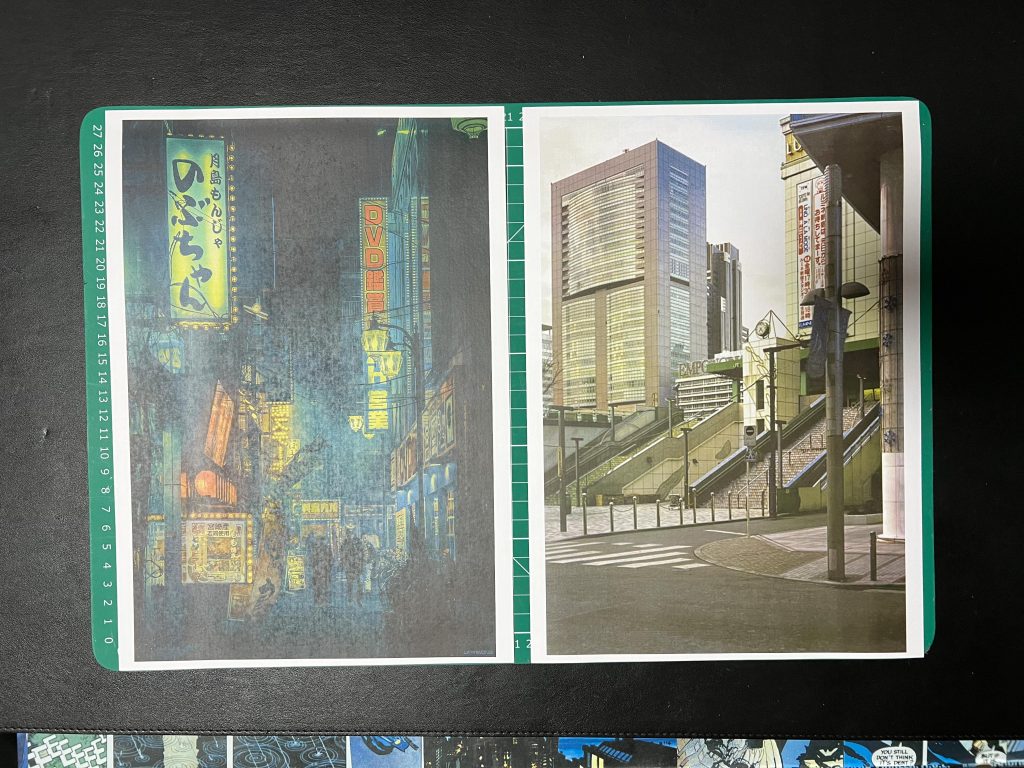
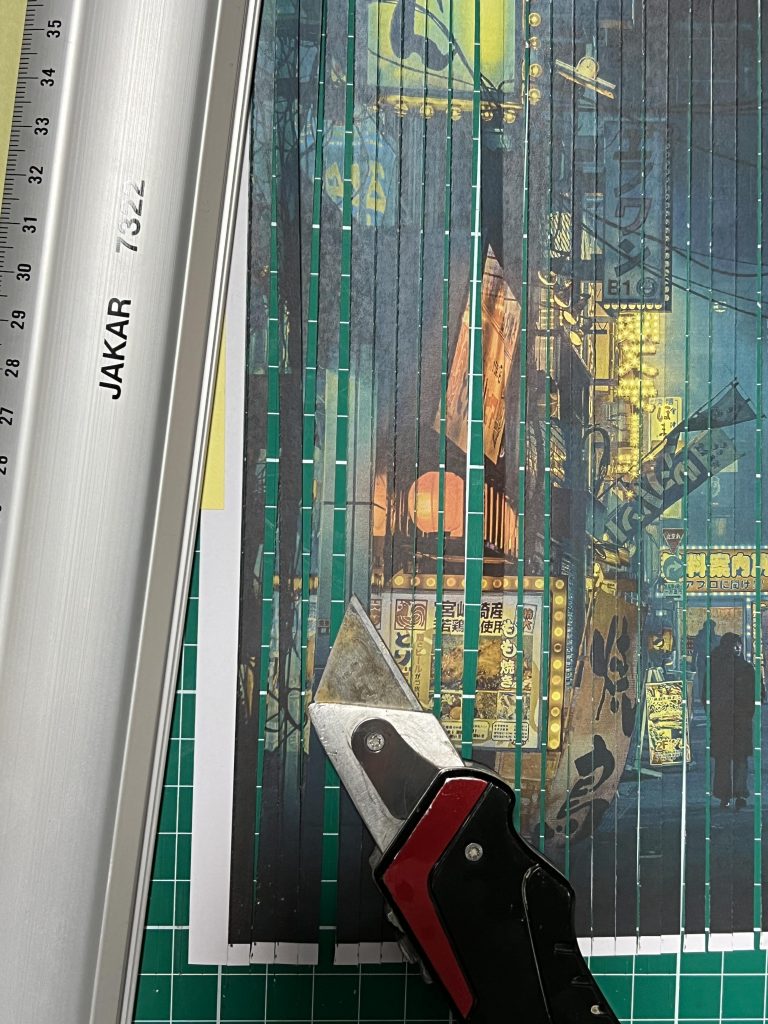

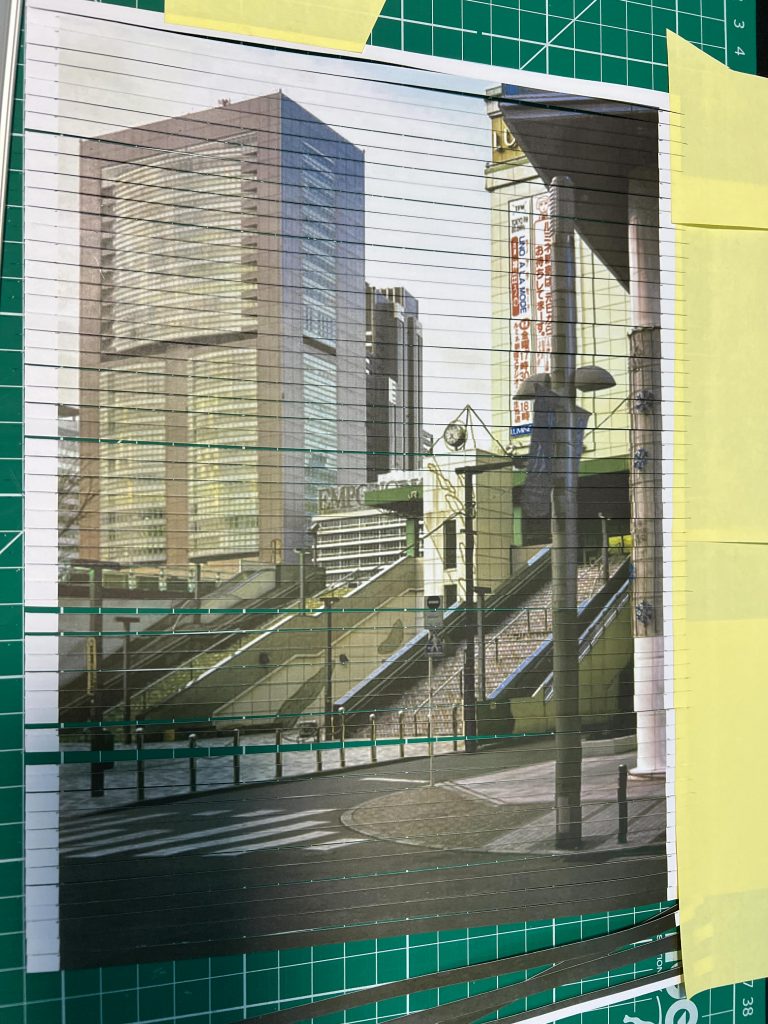

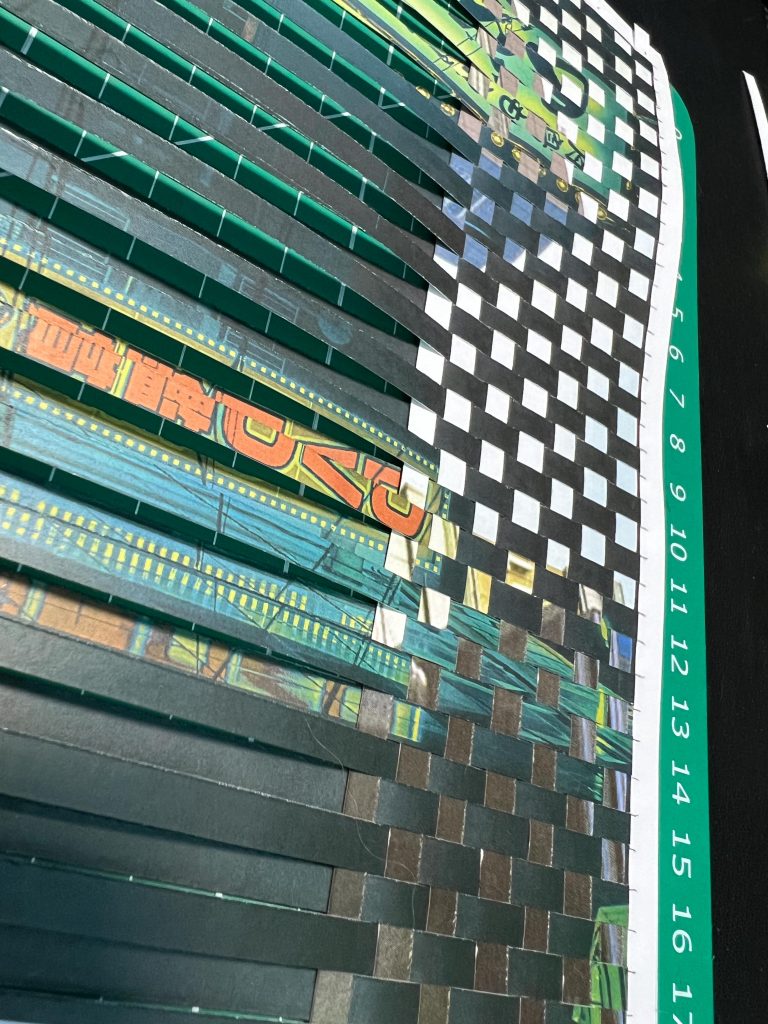
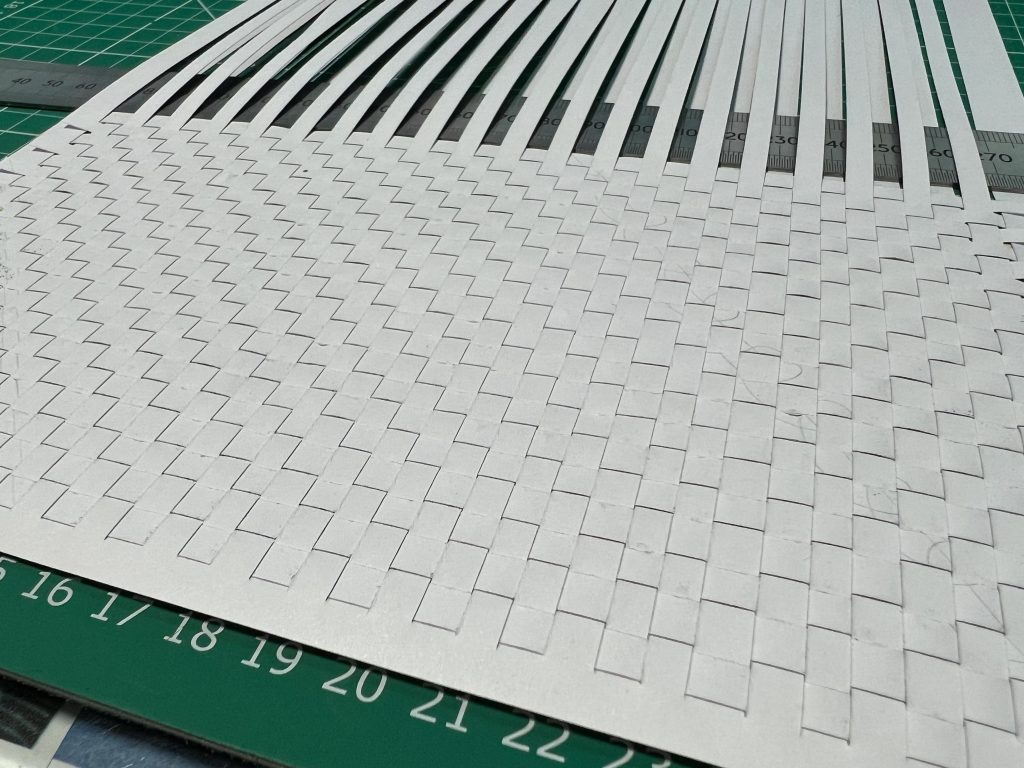
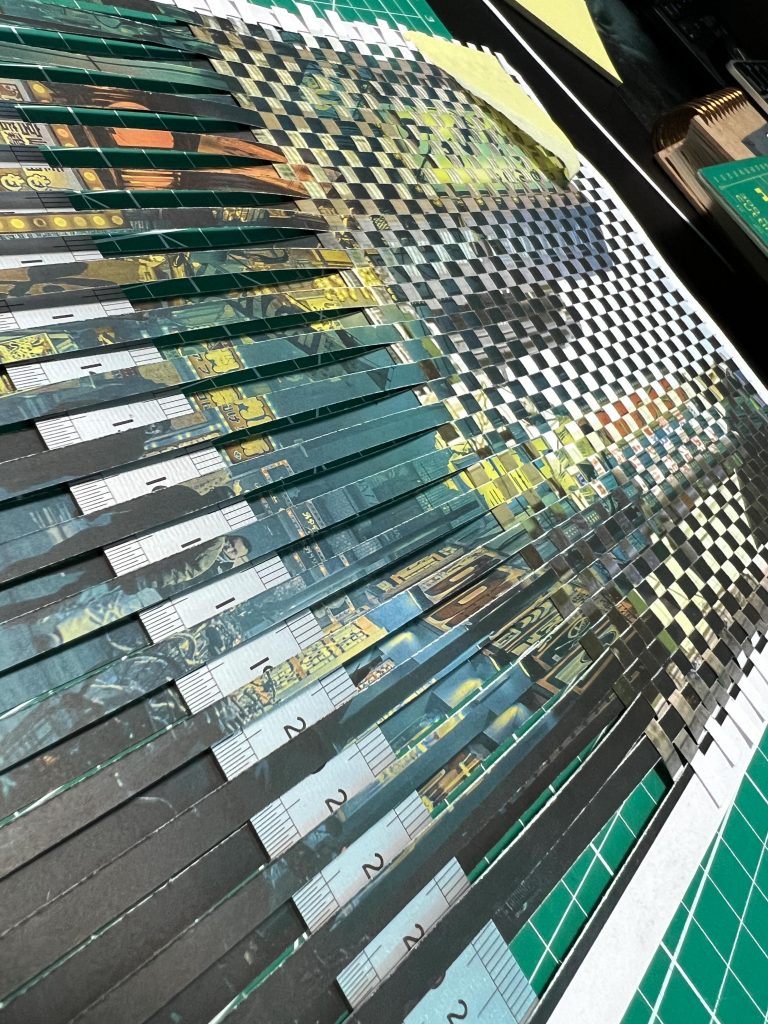
You can see from the gallery of images above that I printed both images out on to a good quality laser printer paper. The Nakano image did need to be cropped width wise to overlay the Wong image but I was careful about which part of the daytime image I selected as it shows the empty part of the shot, avoiding the GAP shopfront with the lights on.
Weaving Together Tokyos
Using the terms of weaving, I cut the Wong image into the “Warp” and the Nakano image into the “Weft” with each strip being 0.5cm wide. I began weaving them together using various different techniques and tools and found it to be incredibly challenging. The total weaving operation took around 7 hours all together and due to the paper being a bit weak there are some gaps as the paper twisted and stretched a little.
I was pleased with the overall image, see below, as it successfully combines the two photographs into the single plate with a tactile presentation that invites the viewer to get haptic feedback from running the fingers over the surface. The tight checker pattern gives it a satisfying air and the fact that you can see the neon lights and signs on the buildings of the daytime image has worked well.

The sky of the Shinjuku image is greyed out by the dark top half of Wong’s image but I think that this hints to the nature of the city being a mixture of both the dark and light together with the pollution that sometimes fills the streets on hot days when the traffic is particularly heavy.
The combined image is best viewed up close to see the finer details and then a step backwards reveals the view of the city architecture and hides the night hours.
By smashing these two photographs together I think that I have contributed in some way to helping Liam Wong’s work integrate with one of the photos from his favourite photo book that has inspired him in his career as a game designer and photographer. I’ve joined the original and inspired together in a piece of work that pays homage to both of the original artworks and the photographers who originally produced them.
• Identify another artist who reinterprets as part of your independent research
In terms of other artists that use reinterpretation in their work, one of the artists I mentioned above Roy Lichtenstein had a couple of pieces on display in the Tate Modern earlier this year, one of them being the diptych “Whaam!” (1963). In this work of pop art seen throughout the world and as recognisable as Warhol’s works featuring Marilyn Monroe.
In this artwork of an aircraft from the US Air Force is seen shooting at and destroying another aircraft, it uses dots painted with acrylic paint on the canvas to recreate the print style used in comic books. The scale of the image does not come across in the photograph of the work I took in June 2022 but the pair of canvasses is huge.
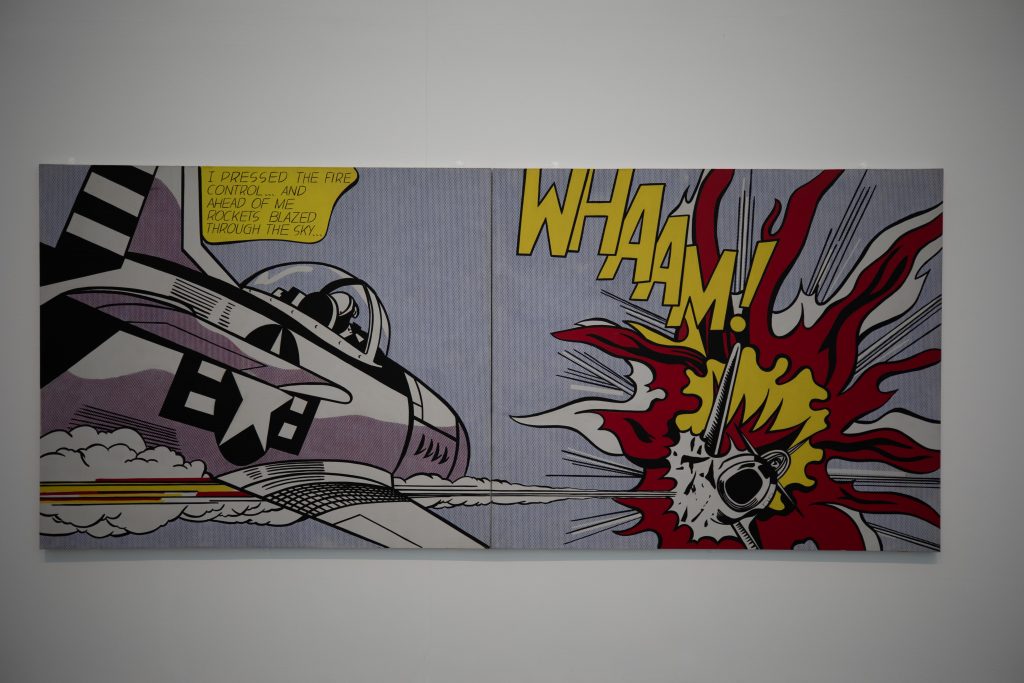
It’s a re-use of the image from a 1962 comic to get across the highly emotive subject of war, aggression and death in a format that is acceptable to kids of the day. I remember the Commando comics from my younger years in which many enemy soldiers were dealt with using rifles and knives. Something which we wouldn’t perhaps see today, apart from in a Call Of Duty computer game, which although they’re 18+ games, it’s well known that younger people regularly play them.
Lichtenstein repurposed the childish image to make a comment on the recent wars as well as the conflict in Vietnam at the time. The bright coloured child friendly image is quite chilling when you consider the contemporary events and how many human lives were being lost to conflicts.
It’s an interesting use of the trope of comics to create a large scale artwork that could be a tribute to comics, a comment on wars, or just a colourful image. It came at a time of Pop Art growing in the early sixties and many of Lichtenstein’s works are as famous as this particular image.
Conclusion
Reinterpretation, as we learnt in our seminar, is an important part of the evolution of art. It reuses ideas, repurposes them, gives new meanings, skews the original meaning, creates controversy and conversations about why something was used in this new manner.
My reinterpretation of the two Tokyo photos is not groundbreaking but for me I feel that it helps me to consider the dichotomy of the city, and I will continue to consider this contradiction of the same space in different times. I already have done this with some of my work on the Multi Storey Car Park in which I revisit it throughout the day and night,
It’s definitely a good exercise to read the images produced by these artists and then consider how they can be altered to form a different narrative, and I’ll also be more cynical when I see art used in advertising to sell consumers things they might not need.
[…] then went into the weaving phase where I have mixed images of portraits together, along with a night and daytime scene in Tokyo and recently the 10×12 images of concrete and shadows in the Multi Storey car park in my home […]
[…] part of a Reinterpretation exercise for Alice I found myself looking at some images by Liam Wong and Masataka Nakano and I chose to […]